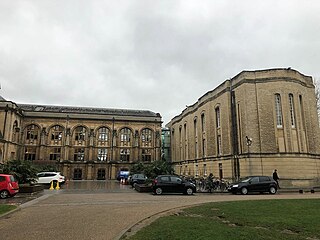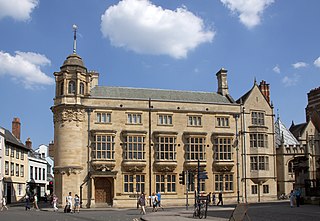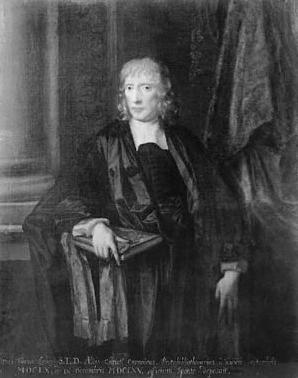
The Radcliffe Camera is a building of the University of Oxford, England, designed by James Gibbs in a Baroque style and built in 1737–49 to house the Radcliffe Science Library. It is sited to the south of the Old Bodleian, north of the Church of St Mary the Virgin, and between Brasenose College to the west and All Souls College to the east. The Radcliffe Camera's circularity, its position in the heart of Oxford, and its separation from other buildings make it the focal point of the University of Oxford, and as such it is almost always included in shorthand visual representations of the university. The Radcliffe Camera is not open to the public.

The Bodleian Library is the main research library of the University of Oxford, and is one of the oldest libraries in Europe. It derives its name from its founder, Sir Thomas Bodley. With over 13 million printed items, it is the second-largest library in Britain after the British Library. Under the Legal Deposit Libraries Act 2003, it is one of six legal deposit libraries for works published in the United Kingdom, and under Irish law it is entitled to request a copy of each book published in the Republic of Ireland. Known to Oxford scholars as "Bodley" or "the Bod", it operates principally as a reference library and, in general, documents may not be removed from the reading rooms.

Cambridge University Library is the main research library of the University of Cambridge. It is the largest of over 100 libraries within the university. The library is a major scholarly resource for members of the University of Cambridge and external researchers. It is often referred to within the university as the UL. Thirty-three faculty and departmental libraries are associated with the University Library for the purpose of central governance and administration, forming "Cambridge University Libraries".

Richard Ovenden is a British librarian and author. He currently serves as the 25th Bodley's Librarian in the University of Oxford, having been appointed in 2014. Ovenden also serves as the Director of the Bodleian Library's Centre for the Study of the Book and holds a Professorial Fellowship at Balliol College. Ovenden is a trustee of the Chawton House Library and vice-chair of the Kraszna-Krausz Foundation. In 2009, he was elected chair of the Digital Preservation Coalition, replacing Dame Lynne Brindley in a post he held until 2013. He was elected to the American Philosophical Society in 2015. He is a Fellow of the Society of Antiquaries of London, having been elected in 2008.

The Radcliffe Science Library (RSL) is the main teaching and research science library at the University of Oxford in Oxford, England. Being officially part of the Bodleian Libraries, the library holds the Legal Deposit material for the sciences and is thus entitled to receive a copy of all British scientific publications.
Oxford Libraries Information System (OLIS) was an online union catalog of books held by the libraries of the University of Oxford, England, which include the Bodleian Libraries group, and also those faculty libraries which are not members of the group, and the libraries of individual colleges. It operated the Geac ADVANCE integrated library system (ILS). Prior to 1996 it operated DOBIS/LIBIS software. Oxford University Library Services (OULS) issued a tender for new software in 2005 which culminated in the selection of the Virtua system from VTLS, but in August 2008 Oxford announced that the implementation would not go forward. In 2010 it was confirmed that Aleph from Ex Libris would replace Geac ADVANCE. Aleph was implemented in July 2011.
The Indian Institute Library is a dependent library of the Bodleian and part of the University of Oxford in Oxford, England. Opened in 1886, the library specialises in the history and culture of South Asia, Tibet and the Himalayas. The Indian Institute and its library were originally based in the building on the corner of Holywell and Catte Street. It was subsequently occupied by the History Faculty and History Faculty Library.. Traces of the building's original function are still visible, including the gilded weathervane which depicts an elephant with a howdah.
Sarah Elizabeth Thomas is an American librarian best known for her leadership positions in a number of research libraries. In May 2013 it was announced that she had been appointed vice president for Harvard University Library; she took up the post in August 2013.

The Indian Institute was an institute within the University of Oxford. It was started by Sir Monier Monier-Williams in 1883 to provide training for the Indian Civil Service of the British Raj. The institute's building is located in central Oxford, England, at the north end of Catte Street, on the corner with Holywell Street, and facing down Broad Street from the east.

The Bodley Medal is awarded by the Bodleian Library at Oxford University to individuals who have made "outstanding contributions ... to the worlds of communications and literature" and who have helped the library achieve "the vision of its founder, Sir Thomas Bodley, to be a library not just to Oxford University but also to the world".

The head of the Bodleian Library, the main library at the University of Oxford, is known as Bodley's Librarian: Sir Thomas Bodley, as founder, gave his name to both the institution and the position. Although there had been a university library at Oxford since about 1320, it had declined by the end of the 16th century. It was "denuded" of its books in 1550 in the time of King Edward VI when "superstitious books and images" that did not comply with the prevailing Anglican view were removed. Poor management and inadequate financial resources have also been blamed for the state of the library. In the words of one history of the university, "as a public institution, the Library had ceased to function." Bodley volunteered in 1598 to restore it; the university accepted the offer, and work began soon afterwards. The first librarian, Thomas James, was selected by Bodley in 1599. The Bodleian opened in 1602, and the university confirmed James in his post. Bodley wanted the librarian to be "some one that is noted and known for a diligent student, and in all his conversation to be trusty, active, and discrete, a graduate also and a linguist, not encumbered with marriage, nor with a benefice of Cure". James, however, was able to persuade Bodley to let him marry and become Rector of St Aldate's Church, Oxford.
David George Vaisey CBE is a British librarian who was Bodley's Librarian from 1986 until 1996.
Sir Arthur Ernest Cowley, was a British librarian who was Bodley's Librarian from 1919 until a couple of months before his death. He was also a leading Semitic scholar.

Edward Williams Byron Nicholson was a British author and Bodley's Librarian, the head of the Bodleian Library at the University of Oxford, from 1882 until his death in 1912.

Thomas Lockey was an English librarian and Anglican priest, who was Bodley's Librarian from 1660 to 1665.
Reginald Philip Carr is an English librarian, who was Bodley's Librarian from 1997 until his retirement in 2006. He is a member of the Christadelphian church.
Francis Wise was an academic, archivist, librarian and antiquarian at the University of Oxford.
The Faculty of History at the University of Oxford organises that institution's teaching and research in medieval and modern history. Medieval and modern history has been taught at Oxford for longer than at virtually any other university, and the first Regius Professor of Modern History was appointed in 1724. The Faculty is part of the Humanities Division, and has been based at the former City of Oxford High School for Boys on George Street, Oxford since the summer of 2007, while the department's library relocated from the former Indian Institute on Catte Street to the Bodleian Library's Radcliffe Camera in August 2012.

The Weston Library is part of the Bodleian Library, the main research library of the University of Oxford, reopened within the former New Bodleian Library building on the corner of Broad Street and Parks Road in central Oxford, England.
The Gladstone Link is an underground library of the University of Oxford that connects the Bodleian Library with the Radcliffe Camera. It was developed and opened to readers on 5 July 2011. It is named after former Prime Minister William Gladstone, who had also studied at Christ Church. It is more modern than traditional Oxford Libraries, many of which are members of the Bodleian Libraries.











